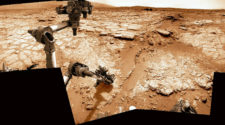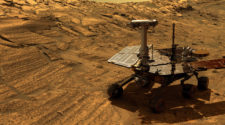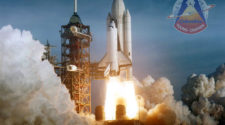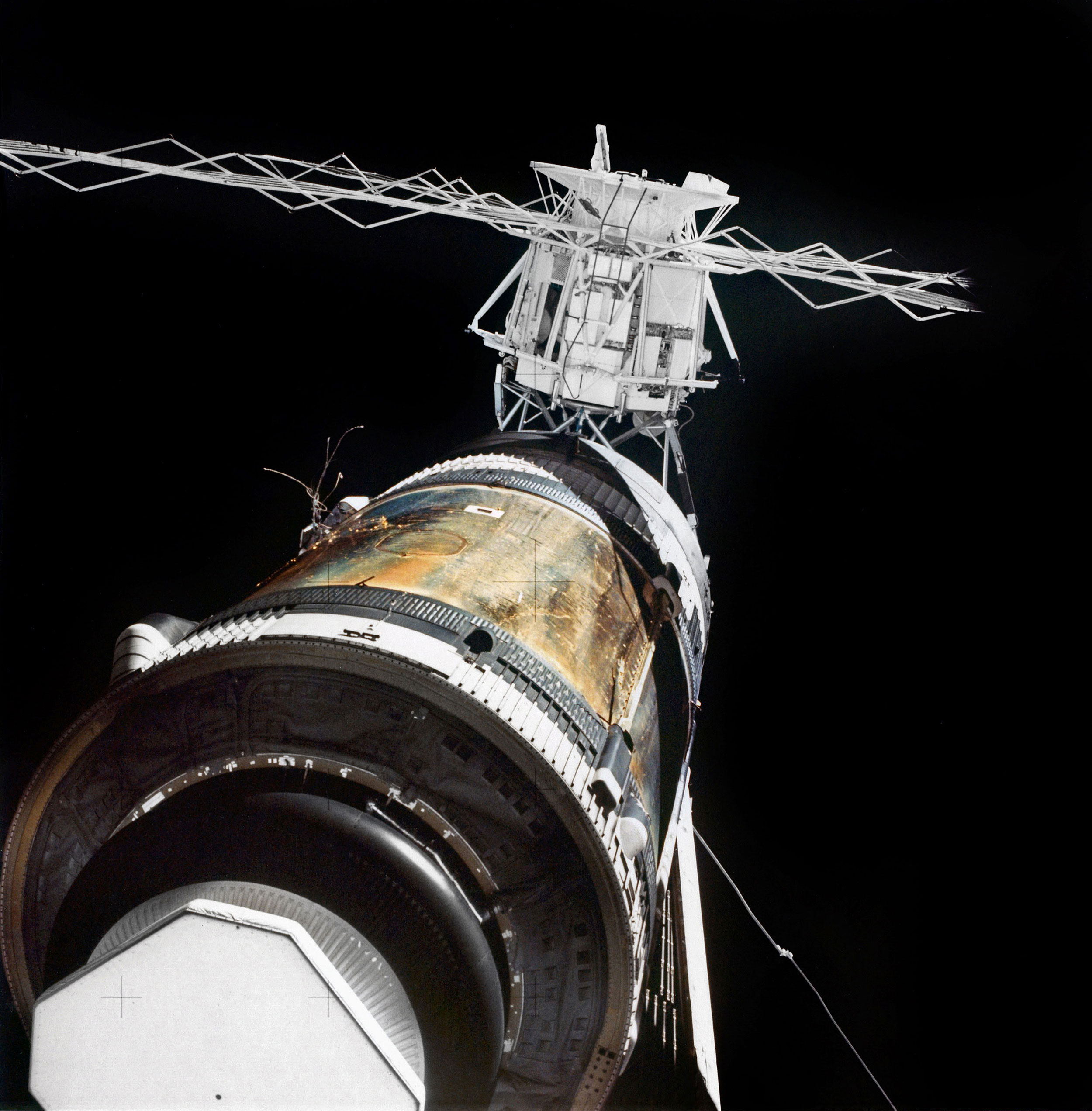
The launch of any new spacecraft cannot be regarded as ‘routine’; nor, indeed, can its inaugural checkout in orbit. The Skylab orbital workshop was an entirely new concept for the United States and a totally different spacecraft, larger, more spacious and in many ways far more complex, than any that had gone before.
Yet on the morning on 14 May 1973, a sense of optimism pervaded the Kennedy Space Center, as the last in a generation of Saturn V boosters was readied for its journey into space. Visually, it looked somewhat different to its lunar predecessors, for, instead of possessing three stages, it had only two, and in place of what would have been the final propulsive stage was the inert Skylab, capped-off by a bullet-like aerodynamic shroud.
With a near-perfect launch record, there was every expectation that the final Saturn V would perform admirably.
Launch at 1:30 p.m. EST seemed pleasing, with the vehicle going supersonic a minute after leaving the pad.
Then, telemetry in Mission Control showed the first indications that something was amiss. As Dave Shayler wrote in Skylab: America’s Space Station, “The data, which went almost unnoticed, indicated a premature deployment of the protective micrometeoroid shield and the No. 2 workshop solar array.” If it was not simply an instrumentation error, this signified very bad news for Skylab. If the micrometeoroid shield and one solar array had indeed deployed during the initial boost to orbit, they were as good as lost and the very future of the space station would hang by a thread.
The Saturn flew its pre-programmed ascent profile, with the second stage taking over when the S-IC first stage burned out. The five J-2 engines of the S-II second stage were automatically commanded to burn for a little longer than normal in order to compensate for the additional weight. Within ten minutes of leaving the Cape, the S-II shut down crisply and the next milestone was for the instrument unit atop the workshop to ready Skylab for orbital operations. The shroud separated and then, at 1:47 p.m., electric motors rotated the giant Apollo Telescope Mount (ATM) out 90 degrees. After it had locked itself into place, the ATM’s windmill of solar arrays was deployed.
In the euphoria of those first few minutes, the mysterious piece of telemetry about the micrometeoroid shield and the workshop’s own solar arrays almost went unnoticed.
Almost…
Within an hour of liftoff, Flight Director Don Puddy reported erratic signals. The main solar arrays should have been deployed when Skylab passed beyond the Madrid tracking station in Spain.
Tensions began to rise in Houston, as NASA managers listened for news from the tracking station, at Carnarvon in Western Australia.
The data was confusing. Controllers expected that their monitors would show the two large solar panels fully deployed and producing about 12.4 kW, some 60 percent of the required electrical load. It was with surprise and dismay, therefore, that the data indicated that power levels were much, much lower…at a mere 25 watts, in fact! The Carnarvon data suggested that the arrays had released for deployment, but had not fully extended, whilst temperature signals from the workshop implied that one array had either been torn away or had suffered severe structural failure, whilst the other had been released, but had not properly deployed.
The data from the next few orbits confirmed a failed micrometeoroid shield and a power outage owing to a solar array malfunction. These concerns were amplified later in the afternoon when telemetry pointed to an electrical short in the pyrotechnic relay needed to release the arrays.
In Mission Control, off-duty flight director Phil Shaffer set to work implementing a malfunction list to handle the myriad problems which were now flooding in from Skylab. “Puddy didn’t have time for it,” Shaffer related, in an interview quoted by David Hitt, Owen Garriott and Joe Kerwin in their book Homesteading Space. Within an hour or two of starting the list, Shaffer found that it already ran to nearly 50 mission-critical items! “At that point,” he continued, “we stalled out on the post-insertion activation sequence…and stuff just kept failing and we could see it was beginning to get hot inside Skylab.”
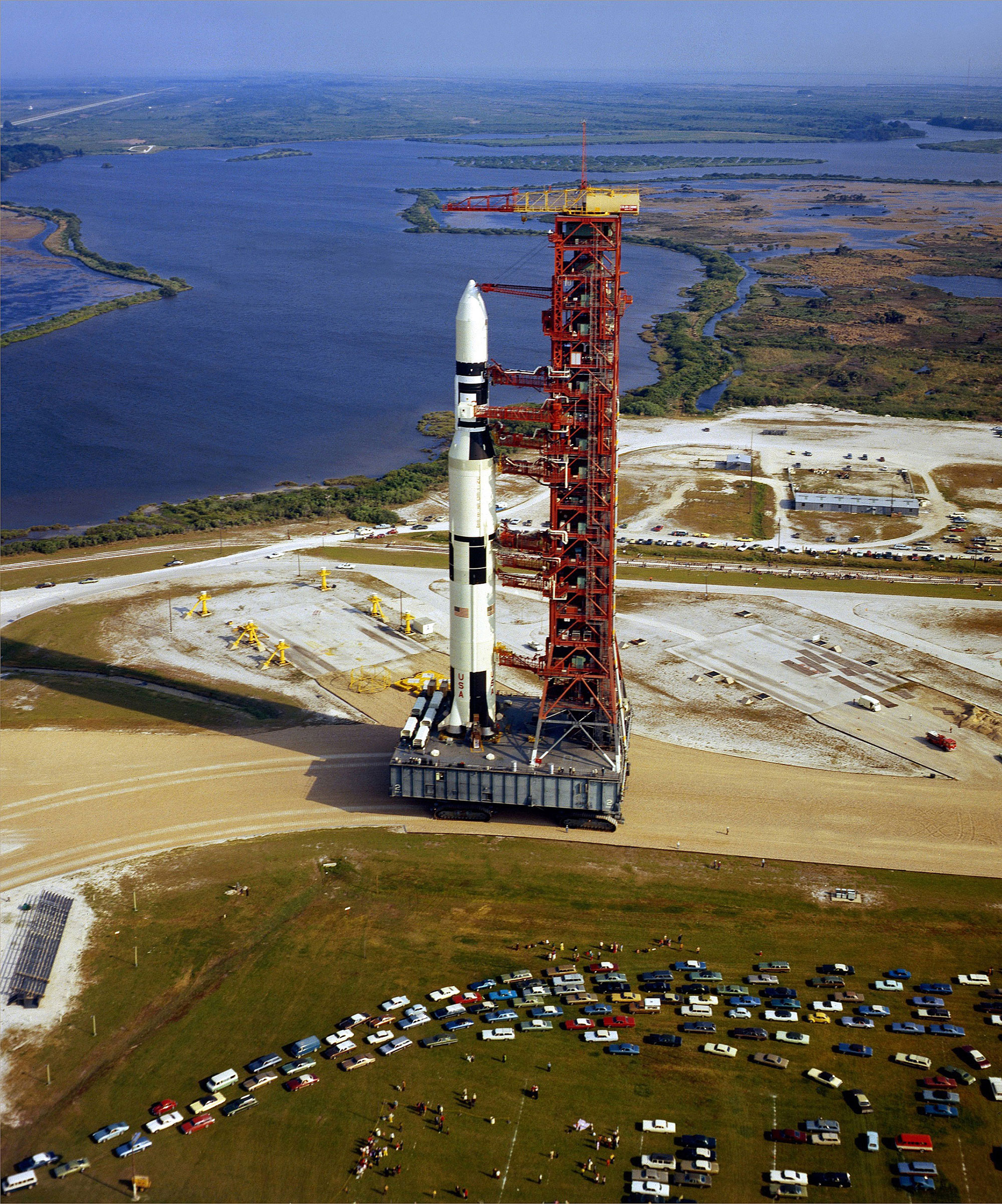
It was certain that Pete Conrad, Kerwin and Paul Weitz would not be flying on 15 May and their launch was scrubbed within eight hours of Skylab reaching orbit. Based on the station’s orbital geometry, launch opportunities occurred every five days and the mission was tentatively rescheduled for no earlier than 20 May. The astronauts flew back to Houston in their T-38 jets to develop a new flight plan, which called for a 17-day ‘nominal’ mission, then ‘minimal activity’ for a further 11 days in order to gather the medical data for a full four-week residency.
However, as this plan began to crystallise, the situation worsened. In order to produce electricity, Skylab needed to remain in a ‘solar inertial attitude’, with the Sun’s rays perpendicular to the ATM solar panels, but this exposed the full length of the workshop to excessive overheating.
For a time, Mission Control limited the problem by pointing the front ‘end’ of the station directly at the Sun. This lowered temperatures…but also reduced power levels. The best compromise, it was found, was for Skylab to be pitched ‘upwards’, about 45 degrees, towards the Sun. This permitted just enough sunlight to illuminate the ATM arrays and charge their batteries for the next period of orbital darkness, whilst also stabilising internal temperatures at around 42°C. Conversely, and somewhat ironically, temperatures in the airlock actually dropped precipitously and threatened to freeze heat exchangers and coolant loops by 18 May. Manoeuvres to warm the airlock succeeded, but at the expense of overheating the rest of the station. Therefore, the problem of maintaining this fine balance between temperature and power was extremely difficult.
Although it was clear that some sort of repair was critical, there was one saving grace: not all of Skylab’s exterior required protection. In fact, covering the part of the workshop’s exterior which directly faced the Sun would serve to bring temperatures within satisfactory limits and, furthermore, such a ‘shade’ would not need to be tied down or composed of strong or rigid material. In the hours after the accident, options for developing this material were exhaustively brainstormed throughout NASA and the proposals came thick and fast, ranging from spray paints, inflatable balloons and wallpapers to window curtains and extending metal panels.
At length, ten options were short-listed for closer inspection, within the guidelines that they must be lightweight, fit inside the cabin of the command module for transportation and were fairly straightforward to deploy. These options were ultimately winnowed down into three finalists: (1) the extension of a sunshade across the exposed hull of the workshop, erected by means of a long pole affixed to the ATM, (2) a sunshade deployed from the command module’s hatch whilst station-keeping or (3) a sunshade deployed through Skylab’s solar-facing scientific airlock.
Of these, Option 2 was the least technically complex, although its key obstacle was that Conrad, at the command module’s controls, would be forced to hold position alongside the workshop, whilst his colleagues opened the hatch to put the sunshade in position.
The first option to erect such a shield would require additional EVA training. The third option would require the development of a shade which was capable of passing through a 20 cm3 opening and then unfurling to cover an area of 7 m2. It also meant that the scientific airlock would have to be sacrificed.
Conrad’s crew had already done extensive EVA training on the ATM and felt that with the availability of suitable hand-holds and foot restraints, they could complete Option 1. Similarly, Option 3 was also ‘doable’, because they could at least work from within the pressurised – but very hot – confines of the workshop itself. At length, since no one knew if the scientific airlocks were cluttered with debris, Option 3 was ranked last and the Johnson Space Center set to work on Option 2 and the Marshall Space Flight Center explored Option 1.
The Houston group envisaged a scenario in which an astronaut (probably Paul Weitz) would perform a stand-up EVA (SEVA) in the open hatch of the command module and attach the sunshade in two places to the aft section of Skylab. Conrad would then manoeuvre his spacecraft to the forward end of the station, deploying the shade in the process and finally Weitz would make a third attachment at the ATM. This sunshade very quickly gained the moniker of ‘SEVA sail’ and its development was conducted under the auspices of Caldwell Johnson. For ten days, his staff worked on the shade, seamstresses stitched the orange material, parachute packers folded it for deployment, engineers attended to its various fasteners…and a steady stream of public tours gawped from a mezzanine gallery at what was going on.
Meanwhile, in Huntsville, the plan was to perform an EVA from the ATM itself. Their sunshade resembled a window blind and its design was completed on the evening of 15 May. Joe Kerwin and the backup commander, Rusty Schweickart, flew to the Marshall Space Flight Center to participate in underwater EVA tests of both sunshades.
“One by one,” recalled Schweickart of the exhaustive two-hour-plus session, “we eliminated things and by about midnight…we basically had the outlines of what we were going to do.”
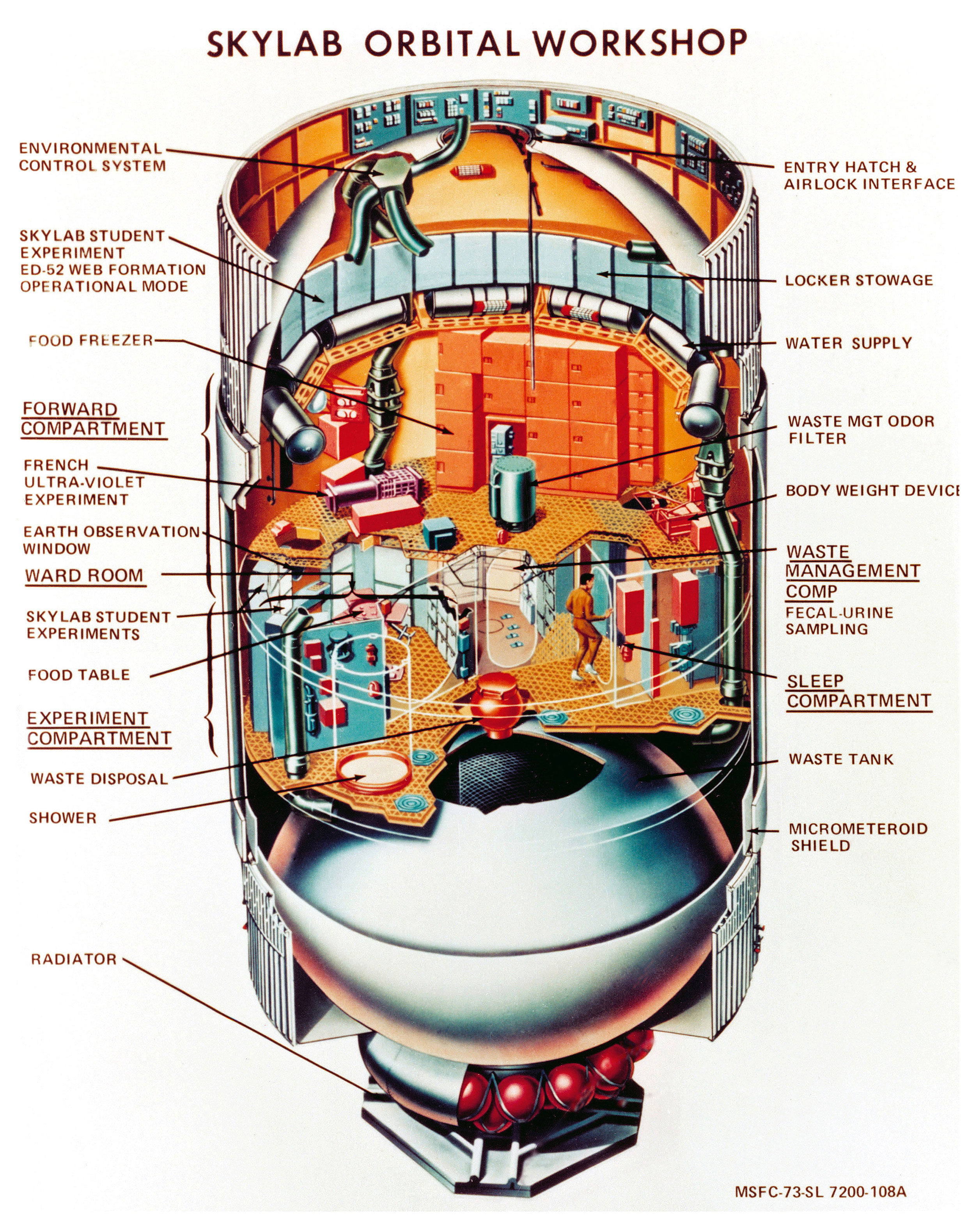
The Huntsville sunshade needed further work and the design which steadily evolved was a configuration of two 14 m long poles, which would be ‘cantilevered’ from the ATM. The poles would be assembled from a dozen smaller sections, allowing them to fit inside the command module, and a rope would run along their length, through a series of eyelets. The 7 x 6 m sunshade would be unfurled by tugging on the rope in a similar fashion to hoisting a ship’s sail. This design came to be known as the ‘twin-pole’ sail.
An underwater test by Rusty Schweickart and Kerwin on 18 May showed that it would work, but also indicated that its pole sections might separate under stress. A locking nut was modified, the shade’s weight was reduced and Teflon inserts were placed into the eyelets to reduce friction. Thereafter, the remainder of the work ran without a hitch.
Meanwhile, the option to deploy a sunshade from the scientific airlock had been revived and was steadily gaining momentum, with a concept that came to be known as ‘the parasol’. Tests showed that a combination of coiled springs and telescoping rods could fit inside a standard airlock experiment canister and could be deployed smoothly. Jack Kinzler, chief of the Johnson Space Center’s technical services division, a close friend and neighbour of Conrad, developed the system by jury-rigging it from a parachute canopy and telescoping glass-fibre fishing rods in hub-mounted springs.
During a final review at the Kennedy Space Center on 19 May, Kinzler’s parasol was accepted as the primary method and on the 24th the flight readiness review endorsed it. Having an astronaut standing in the hatch on an EVA was undesirable, since it would come at the end of a long, 22-hour day for the crew.
Equally, the twin-pole concept did not meet with the approval of the flight surgeons, who were aghast at the prospect of such a complex task so early in the mission, before the crew had properly acclimatised to weightlessness. However, Conrad felt that Kinzler’s design was the simplest, safest and quickest method…and most likely to succeed.
Years later, Schweickart glowingly praised the efforts of the industrial and NASA workforces to save Skylab during those frantic days of May 1973. “I probably got a little bit of sleep,” he recalled, “but most of the team who worked with me at Huntsville never slept for four days! It was totally round-the-clock and it was not just the resources of the centre; it was all of the resources of the whole aerospace industry.”
Kerwin felt the same. “It was a great team,” he reflected. “I look on Apollo 13 as the supreme test…for the Mission Control team. The Skylab problem was the supreme test for the engineering team. Both the contractors and the civil servants joined together, as one, and they figured out what the problem was.”
Of course, the state of the arrays and the reason for the No. 2 array being unable to properly unfurl, could only be speculated until the arrival of Conrad’s crew and the presence of three sets of eyes to physically see what was amiss. If debris was the problem, a repair method was acutely needed and engineers from the Marshall Space Flight Center set to work to adapt a cable cutter (not dissimilar to a heavy-duty tree lopper) and a universal tool with prongs for prying and pulling to open the jammed array.
On 19 May, the tools were successfully tested in Marshall’s neutral buoyancy tank, with the Skylab mockup specially ‘modified’ with fragments of metal wire bundles, shards of bolts and other objects representative of a failed micrometeoroid shield. Conrad, Kerwin and Weitz took their turns underwater, evaluating the tools, practicing prying the debris away from the array and completing the whole procedure safely.
The tools had already left for the Kennedy Space Center when a certification review ruled that the pointed tips of the cutter were hazardous. New heads with blunt tips were quickly prepared and the change was made at the launch site. Now, however, the time for talking was over. Years later, in her book Rocketman, Nancy Conrad related that Pete’s response to the seemingly endless testing was typically to the point: “Just get me up there!”
With their launch scheduled for the stroke of 9:00 a.m. EST, the morning of 25 May 1973 was particularly peaceful for the three astronauts.
“This was the least well-attended Apollo launch in history,” Kerwin recalled, “because everybody had to go home and put the kids back in school. We arrived at the command module and looked inside and it was a sea of brown rope under the seats and under the brown ropes were all these different umbrellas and parasols and sails and also the equipment that we had selected to try and free up the solar panel, which was a pretty eclectic collection of aluminium poles that could be connected together, and a Southwestern Bell Telephone Company tree-lopper with brown ropes to open and close the jaws. They handed us the checklist and said ‘This is how to operate that stuff.’ Some of it we’d seen, some of it we hadn’t!”
The astronauts were unperturbed. Indeed, as their Saturn IB rocket cleared the Pad 39B tower and roared into the clear morning sky, Conrad declared that his crew could fix anything.
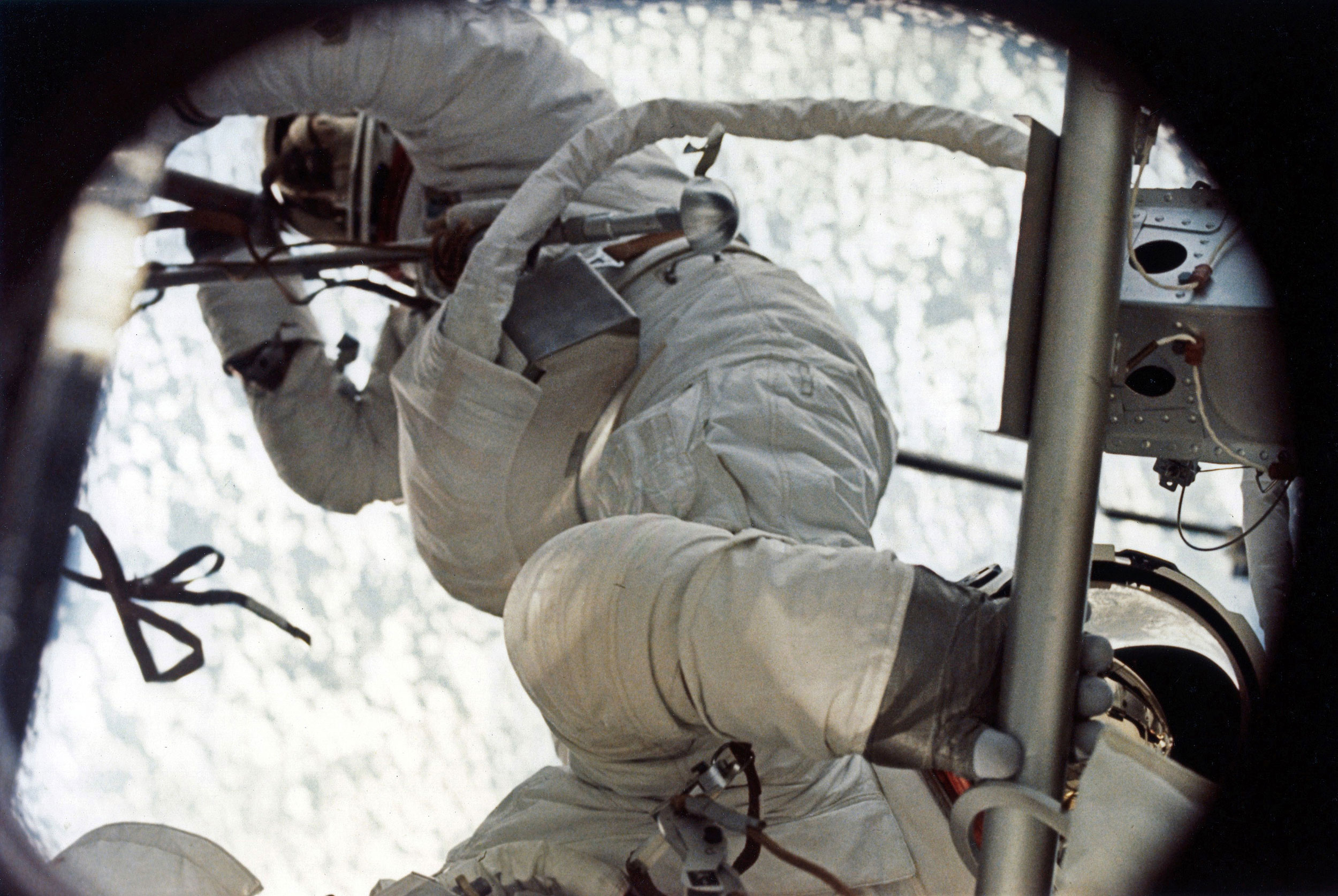
Launch was on time and kicked off an eight-hour orbital ballet to rendezvous with the crippled station. Conrad’s call of “Tally-ho the Skylab!” as a steadily brightening star on the horizon drew closer masked, at first, the seriousness of what the astronauts were about to face.
The micrometeoroid shield was indeed gone, as was one of the two solar arrays, whilst the second was jammed by debris. As Weitz took pictures, Conrad performed a flyaround inspection, quickly ascertaining that the scientific airlock was not cluttered with debris, thereby making the deployment of the Houston parasol a realistic option, and asserting his conviction that a stand-up EVA with the cutter should be enough to free the jammed solar array.
The first order of business was a ‘soft docking’ at Skylab’s forward port, engaging capture latches but not retracting the command module’s docking probe to ensure a firm metallic embrace.
After a quick lunch, Conrad undocked from Skylab, depressurised the cabin and opened the side hatch. With Kerwin hanging onto his ankles for stability, Weitz tried to use the modified tree loppers and a kind of ‘shepherd’s crook’ to free the jammed array. Unfortunately, despite his sterling efforts, it did not go well.
At first, Weitz positioned himself with his upper body poking through the hatch into the ethereal blackness of space. Kerwin passed him three sections to assemble a 4.5 m pole with the loppers on the end, whilst Conrad kept the spacecraft steady. “We had seen…that there was a piece of bolted L-sections from the thermal shield that had been wrapped up around the top of the solar wing,” Weitz recalled, “and apparently the bolt heads were driven into the aluminium skin. We thought maybe we’d just break it loose, so we got down near the end of the solar array and I got a hold of it with the shepherd’s crook. What we really hadn’t thought about was – in heaving on it, trying to break the thing free – what I was doing, in effect, was pulling the command module in towards the workshop.”
Weitz could quickly ascertain that he was physically moving Skylab, because its thrusters were spitting and spurting to maintain its attitude and correct the oscillations.
Meanwhile, Conrad had the unenviable task of keeping the spacecraft as close as just 60 cm from the station, whilst at the same time trying to prevent the unwanted oscillations from causing a collision. His task was compounded by the fact that a third of his field of view was blocked by the command module’s open hatch. “It made for some dicey times,” Weitz recalled. As the two vehicles entered orbital darkness, he paused in his work, then resumed as they flew within range of the tracking station. The shepherd’s crook was getting him nowhere and the torrent of four-letter words from all three members of the crew even prompted the capcom to advise them to modify their language; for they were on an ‘open mike’.
The main problem, Conrad told the ground, was that a strip of metal had become wrapped across the solar array system during the separation of the micrometeoroid shield. Its metal bolts had tangled themselves in the array, thereby jamming it, and none of Weitz’ actions to cut the strap, even with the loppers, were having any effect.
“Rather than cutting it across the short way, we were trying to cut along the long way,” Weitz explained, “and just didn’t have enough muscle with that thing, because it was six or eight feet out ahead of me and I was pulling on a line to try to do it.”
The metal strap, ironically, was only a few centimetres wide, but it was riveted fast and Conrad knew they did not have a hope of breaking it using the tools in the command module. The attempt was called off and after 40 minutes or so the astronauts were instructed to close the hatch and re-dock with Skylab.
On their first attempt to dock, the probe did not engage with the drogue and no fewer than three further attempts were also fruitless. “Pete gave Weitz the controls,” Nancy Conrad wrote, “depressurised the command module and opened the tunnel hatch. He and Joe dove head-first into the bank of circuits and gizmos, Pete cussing a blue streak as he sorted through wires, cutting and splicing like [an angry] Maytag repairman trying to get a dryer to work again.”
After an hour or so of re-routing and connecting wires, bypassing electrical relays for the capture latches on the tip of the probe, skinning knuckles and a handful of undesirable vocabulary, Conrad used the service module’s thrusters to bring the two collars into direct contact, mechanically triggering the dozen capture latches.
They were at Skylab to stay.
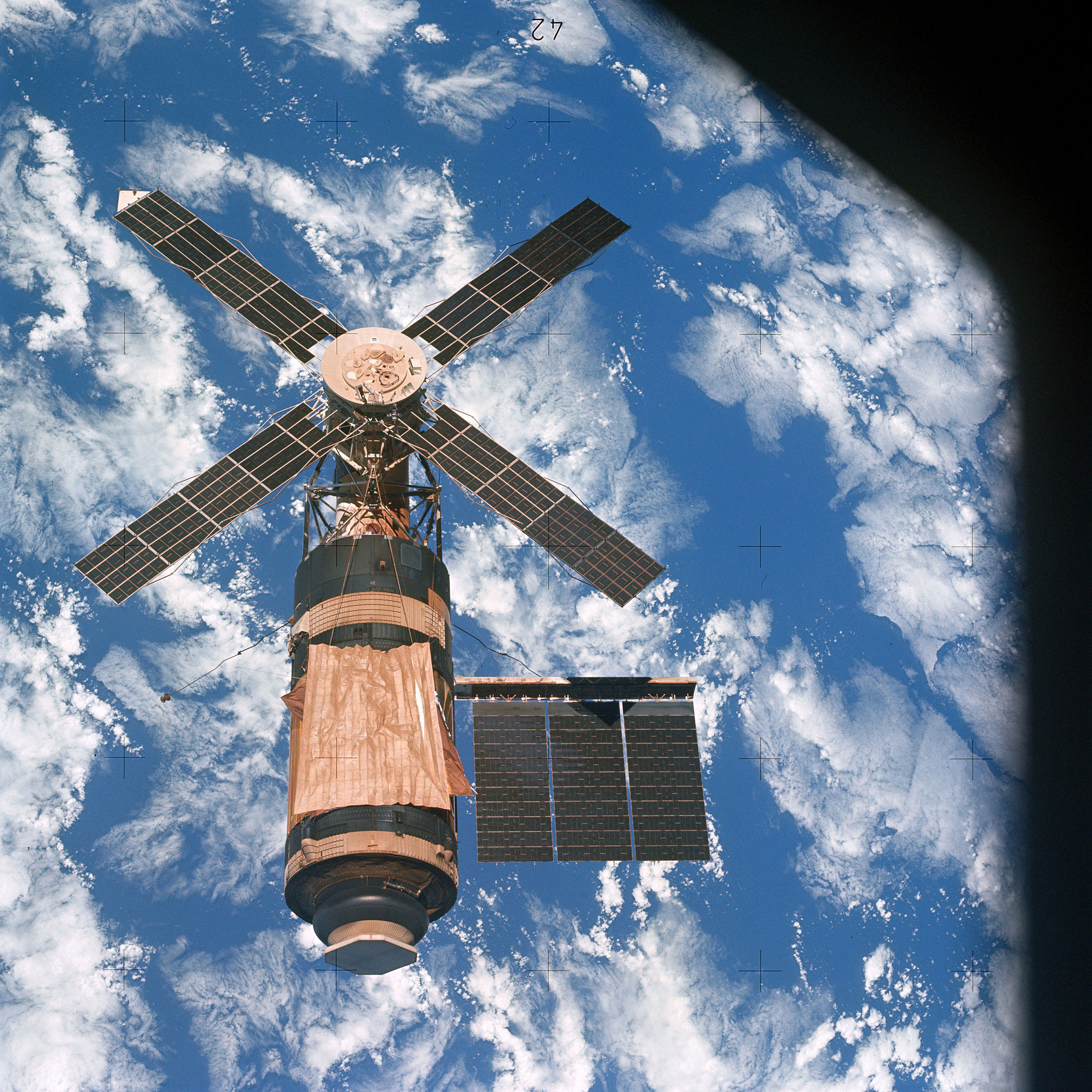
Next morning, the crew opened the hatch into the multiple docking adaptor and Weitz was the first to enter Skylab. Pressure checks were quickly followed by air sampling to test for the presence of noxious toluene and carbon monoxide, both of which gave the workshop’s atmosphere a clean bill of health.
At length, after several hours, the parasol was assembled and at 7:30 p.m. its rods were delicately threaded through the scientific airlock into vacuum. Next, the parasol itself emerged, folding out like a big patio umbrella.
However, all was not right: one of its four folded arms did not swing out properly and Kerwin expressed dismay when he saw it had only deployed to cover two-thirds of its required area. “It’s not laid out the way it’s supposed to be,” a dejected Conrad told Mission Control, as it became clear that the parasol was askew and somewhat crinkled.
Nevertheless, the ground team in Houston assured the astronauts that the wrinkles had probably set in during the coldness of the lengthy deployment, which took place during orbital ‘night-time’, and, as the material heated up in sunlight, it would spread out fully.
“I think the ground noticed the temperatures coming down,” Weitz recalled. “Within an hour, they could tell.” Indeed, overnight on 26/27 May, the temperature on the exterior of the workshop dropped by 55°C and its interior by 11°C. Eventually, the interior temperature stabilised at around 30°C. However, for the mission to survive and succeed, it was necessary to release the jammed array, and soon, and plans were set in motion for an EVA on 7 June.
Since the airlock was right in the middle of the Skylab cluster, with the hatch to the workshop at its aft end and a hatch to the station’s multiple docking adaptor and the command module at its forward end, a fully-suited Weitz had to make sure that Conrad and Kerwin had all of their tools and tethers before he depressurised them. Weitz then retreated into the multiple docking adaptor.
The hatch was opened at 10:23 a.m., just before the workshop entered the dark portion of its orbit. Conrad assembled the tools – six 1.5 m rods were screwed together, the cable cutter was fitted and several metres of rope from the backup SEVA sail were tied to the cutter’s pull rope – and then he and Kerwin moved into position alongside the antenna boom. The unlikely contraption thus enabled them to operate the cutter from 8-9 m away…just far enough from the airlock to the jammed array.
As Kerwin tried to close the cutters against the debris, it became apparent that he was ‘slipping’, because he was unable to establish a secure position for himself. For half an hour or more, with one hand steadying himself and the other trying to close the cutters, he struggled fruitlessly to complete the work. As his pulse rate began to climb, he decided on an alternative course of action and shortened his own tether, in an effort to steady himself against the edge of the workshop. It worked and after ten minutes or so he was able to tell ground controllers in Houston that the cutters were now securely fastened to the debris. Next, he pulled on the lanyard to operate them…and nothing happened.
Conrad made his way, hand-over-hand, along the length of the beam to see what was amiss, and precisely as he reached the cutter ‘end’, the jaws snapped shut, freeing some of the metal strap at 2:01 p.m. and hurling the commander into space. Fortunately, his tether restrained him from moving far from Skylab, and the jammed array now stood at 20-degrees-open.
The frozen damper, however, still resisted normal deployment and the holes on the solar array were smaller than on the ground model. The two men heaved, without success, until Conrad placed his feet on the frozen hinge, stooped to fit the tether over his shoulder and ‘stood up’. Kerwin pulled on the tether and, this time, the solar array suddenly released and sprang into its full, 90-degrees-open position. Both astronauts were flung outwards by the catapult-like effect and arrested by their tethers.
Inside Skylab, the needles of the electricity meters dramatically jumped, signalling success. By the next day, 8 June, solar heating had fully extended the array and it was generating no less than 7 kW of much-needed power. From just 40 percent power, the station’s output suddenly increased to around 70 percent. Against all the odds, Skylab’s fortunes had been snatched from the gaping jaws of defeat. The mission was underway.

